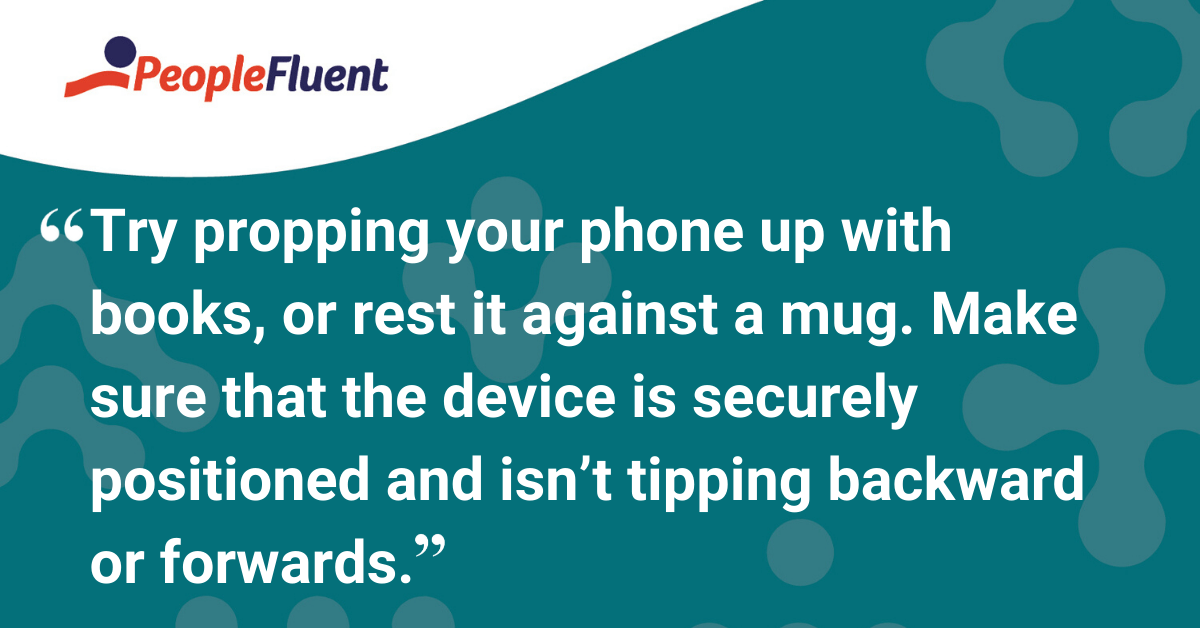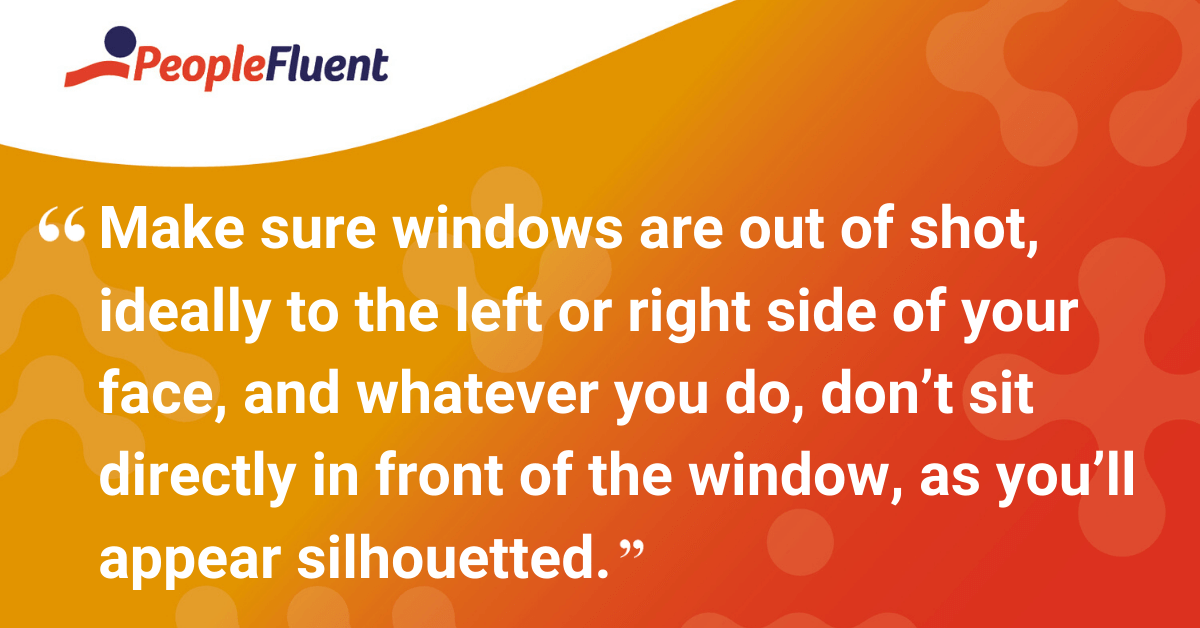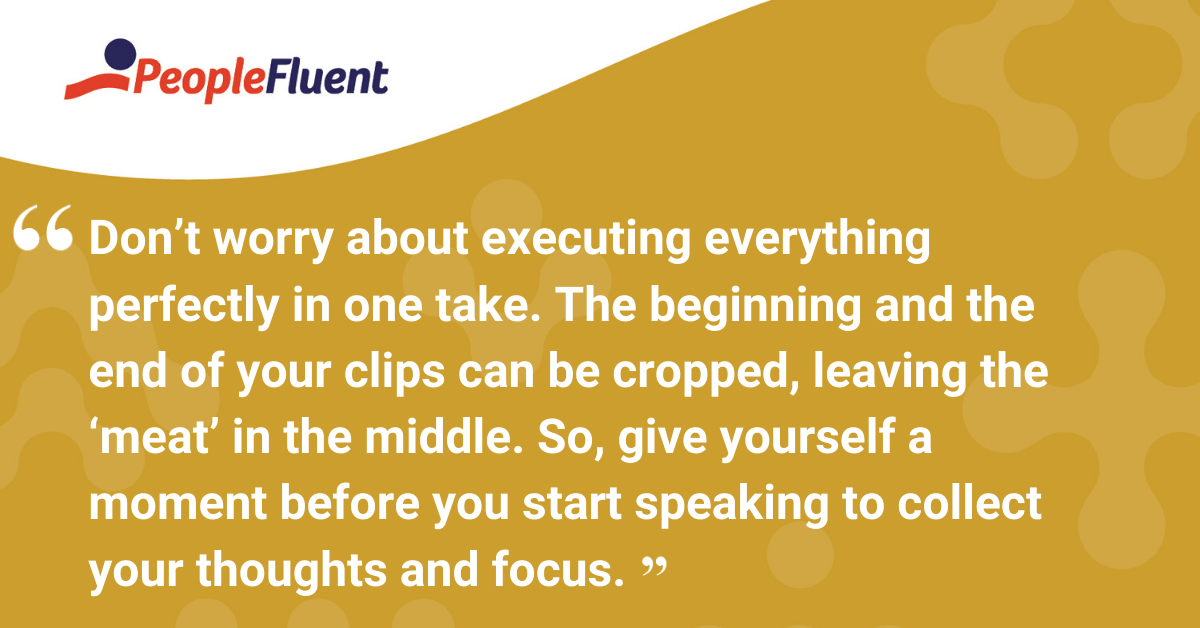Published: Jun 15, 2020Time to read: 6mins Category: Learning
13 Tips for Filming Videos From Home
As we adapt our learning content to the changing world around us, we’ve seen a rise in people creating learning video content from home. In this blog post, Frank McCabe, Executive Producer in charge of Moving Image at our sister company, LEO Learning, talks us through some practical tips on how to get the best audio and video quality with minimal resources.
Large-scale, broadcast-standard video productions may not be feasible in a remote-working world, but that doesn’t mean you can’t still create videos with messages that resonate with your learners. Adapting your video content requires flexibility, but the good news is you don’t need to be a pro to make it work. Individual contributors can record messages that form a powerful part of your learning blend.
Interviews, hints and tips videos, and leadership messages can all be recorded and delivered at distance, and these tips will help polish your video content.And if you're using a Learning Experience Platform (LXP) that offers video-centric content creation, even better!
Related reading: '3 Pillars of the Online Learning Blend That Will Save Your Training Plan'
7 Tips to Improve Picture Quality in Your Home-Video
Here are seven important things to consider to create the best picture quality for your learning videos. It’s worth testing each of these points before you record your final cut. The benefit of recording on your phone is that you can quickly record, review, and adjust as needed.
Use Your Phone, Not a Webcam
Modern-day mobile phones tend to produce much better image quality than a webcam on a laptop, so use these where possible. Phones are of course small and portable, giving you greater flexibility in positioning them and creating the best possible framing for your video.
And flexibility is the name of the game when it comes to finding the best spot possible for a home-recording.
Make Sure Your Record in Landscape
The dimensions of a landscape screen are similar to a standard filming frame (1920x1080). This immediately gives a more professional output compared to shooting in portrait orientation.
Stabilize Your Device for a Steady Recording
A video with too much motion can be hard to watch, so make sure your phone is static when recording. A degree of lenience towards overall quality tends to be given for home recordings, but a shaky image is hard to ignore. Try propping your phone up with books, or rest it against a mug. Make sure that the device is securely positioned and isn’t tipping backward or forwards.
More from the blog: ‘4 Tips for Organizations Using Technology to Train Staff Now Working From Home'

Location, Location, Location!
When filming, be mindful of what’s in your background. Filming with a white wall or plain backdrop can look dull, while unnecessary clutter can distract your viewer. Utilize colorful spaces and interesting interiors.
It’s likely you’ll be using the phone or tablet microphone when recording, which means you need a quiet space. It’s recommended that you film inside to avoid as much background noise as possible (we’ll cover more on audio quality below).
Set up to Allow for Depth of Field
To get the best image possible, you need to create depth of field. This will help separate yourself from the background.
To do this, you need to distance yourself, ideally 2+ meters from your background. Standing too close to a wall will put everything in focus, when actually all you want in focus is the person on camera, with the background blurred out.
The camera should be roughly 1 meter away from the subject, and the interviewee should be 2+ meters away from the background wall.
Consider Your Lighting
Using a room with a window is a good way of obtaining enough light for your interview, and natural light avoids unwanted color hues that may appear with artificial lighting.
But do make sure the window is out of shot, ideally to the left or right side of your face, and whatever you do, don’t sit directly in front of the window, as you’ll appear silhouetted.
Framing Is Fundamental
The camera on the back of a phone or tablet is almost always better than the one on the front, meaning when it comes to filming, you won’t be able to see yourself.
To get around this, get your camera set up and take a few photos using the countdown timer to make sure you’re positioned correctly. You ideally want to be centered in the frame, with just your head and shoulders in shot.
Explore more: ‘6 Reasons Why You Need to Start Using eLearning Video—Today!'

3 Ways to Optimize Your Audio Quality While Recording From Home
Location, Location, Location – Part 2!
Try to give yourself some space! A small room might create a ‘boxy’ sound with reverberation or echo, so finding a decent-sized room is probably better.
An Empty Room Will Reverberate
Bare walls and an empty room without furniture will create a rather stark sound. Try to record in a room with plenty of soft furnishings to ‘deaden’ the sound.
Distance From the Microphone
Whether it’s an external microphone or one in a phone, tablet or laptop, try to find the best distance from it. Ideally, your mouth would be about a foot away from the microphone. With an external microphone, this may mean mounting it on a stand.
Be mindful to keep the microphone out of the frame, if possible.
Avoiding Background Noise
We get used to the hustle and bustle in our lives, to the point where we’ve learned to ignore certain background noises. Make sure you’re in the quietest spot you can find, avoiding places with recurring or ‘sudden’ noise pollution.
You may also like: ‘5 Reasons Why the ‘Netflix of Learning’ May Be a Bad Idea'

Tips for Recording and Editing Your Video
Presenting to camera may not come naturally to everyone, but these next tips are always worth remembering, whether you’re a seasoned pro or just starting out.
Take Your Time When Speaking to the Camera
Don’t worry about executing everything perfectly in one take. The beginning and the end of your clips can be cropped, leaving the ‘meat’ in the middle. So, give yourself a moment before you start speaking to collect your thoughts and focus. Any extra footage at the beginning and end of your recording can easily be cut.
Remember, These Clips Are Short and Dynamic
Bringing the right energy to your clips will have a big impact on the success of our approach. You normally won’t be on screen for very long, so make it count by being:
- Clear
- Energized
- Emphatic
Consider the differences in tone between an academic lecture, a radio ad, and reading a child’s story. They all have very different pacing and energy. Consider what’s right for you, your message, and for your audience.
You might also like: 'Hollywood Hacks: 4 Ideas for Affordable, Professional-Quality Video Learning Content'
A version of this post originally appeared on the LEO Learning blog.
Want to create high-quality video learning without breaking the bank?
An LXP may be just what you need to start making your learning programs creator-centric.